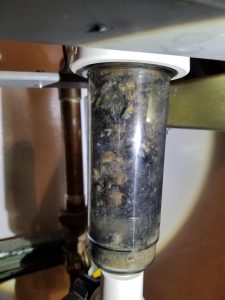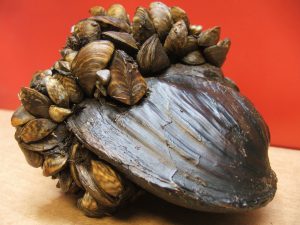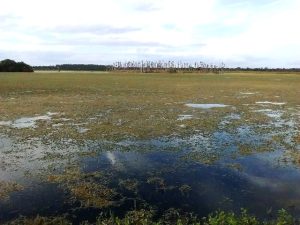3.2 Categories of Water Pollution
Sources of Water Pollution
As with air pollution, water pollution sources can be categorized as point sources or nonpoint sources. Point sources of water pollution are usually pipes or other sources that drain mining, shipping, industrial, agricultural, and municipal waste into bodies of water. Nonpoint water pollution generally enters bodies of water through runoff over the ground or travel through the ground. Nonpoint water pollution can come from pollution on roadways, from yard and agricultural chemicals, mine drainage, faulty septic systems, and pet waste. Air pollution that settles out of the air or is washed out of the air into water or onto land and then into water is also a nonpoint-source of water pollution.
Types of Water Pollution
Water pollution is a subset of water contamination. Contaminants are simply foreign substances, or substances present at higher-than-normal levels, whereas pollutants are contaminants that are harmful to the environment and/or organisms. Thus, all pollutants are contaminants, but not all contaminants are pollutants.
The US EPA classifies drinking-water pollutants broadly into physical, chemical, biological, and radiological categories, and also addresses thermal pollution.
Physical water pollution
Physical contaminants are often referred to as sediments and suspended solids. These are solid materials that do not dissolve in water. Although they may carry adsorbed chemicals, this category of water pollution is concerned only with their impacts as solid materials. Sediment in water is sand, silt, and other kinds of soil that enter waterways as a result of runoff, often from storm water. Suspended solids is a broader category that can also include any debris carried into bodies of water, from microplastics to automobiles – trash, plant and animal debris, microorganisms, soil, etc. Physical contamination reduces water clarity, blocking light to aquatic plants and animals. It may clog fish gills, reduce stream flow, fill in shallow bodies of water, block drainage pipes and restrict water passage for dams and culverts.
Chemical water pollution
Chemical contamination may enter water bodies dissolved in inflowing water, runoff, or groundwater, or may enter as adsorbed chemicals on sediment and other suspended solids that leaches into receiving waters – the lakes and rivers that receive the contaminated water.
Inorganic chemical pollutants
Inorganic chemical pollutants include acids, nutrients from yard and agricultural fertilizers and sewage, salts, heavy metals and radioactive materials (these are treated as a separate category).
Acid rain or snow that reaches streams and lakes can lower their pH. In severe cases, “dead” lakes can occur, in which most plankton, fish, amphibians, and aquatic invertebrates are absent. As we learned earlier, acid rain was a greater problem in the past, but can still occur in the present where high-sulfur coal is burned, particularly in Asia and parts of Russia.
Nutrient pollution is mostly biologically available forms of N (nitrates, ammonia) and P (phosphates) that enter waterways as runoff or drainage from sewage systems, agricultural areas, livestock operations, and municipal and residential properties where fertilizers are produced or applied.
The process of human contamination of waters with nutrient pollution is termed anthropogenic eutrophication. Where soils are naturally higher in nutrients, nearby waters can be naturally eutrophic or highly productive (the opposite – for low-nutrient waters – is oligotrophic). Anthropogenic eutrophication creates even higher levels of nutrients in the water than natural eutrophication. The high levels of nutrients support heavy growth of algae; algae become numerous and reduce water clarity. Algae are short-lived – usually only a few days – and when they die, they sink to the bottom, where bacteria decompose them, using oxygen. But oxygen only diffuses from the atmosphere to the bottom of lakes slowly. As a result, oxygen levels near the bottom of the lake can become too low to support most aquatic life, resulting in death of less mobile bottom life – mollusks and invertebrates – and any more mobile life that cannot find more oxygenated waters – often including many fish.
Severely nutrient-polluted water bodies are termed hypertrophic. Often dense algal mats cover the surface, blocking light to aquatic plants, and fish kills are common, as fish run out of oxygen. One measure of nutrient pollution is biological oxygen demand (BOD), which measures the amount of oxygen needed by oxygen-using decomposers to decompose the organic matter in the body of water. BOD rises with nutrient levels and also with water temperature, as algae can reproduce more quickly in warmer waters (up to a point).
Familiar, toxic heavy metals include arsenic, mercury and lead. Many common metals used in everyday life are also toxic – copper, iron, silver, zinc, nickel. Others include chromium and platinum. Heavy metals vary in the nature of their toxicity, but can inactivate enzymes, cause neurological problems, and trigger cancers, among other forms of toxicity.
Lead is of particular concern in drinking water because many early water-distribution systems in the US and elsewhere were built using lead pipes. Lead is relatively inexpensive and easy to work and the lead industry pushed hard to continue its use. The risk from lead was recognized by the late 1800s, and cities began moving away from lead pipes in by the 1920s. Nevertheless, a nationwide ban on new lead pipes in drinking-water systems was not passed until 1986, when it became part of the Safe Drinking Water Act. That ban did not require replacing existing lead pipes, and older cities and homes still contain some lead pipes.
Salt pollution occurs most often from road salt (mostly NaCl – the same chemical as table salt), but can also result from mining and industrial wastes. Most aquatic organisms have somewhat narrow tolerances for salinity, and organisms that live in freshwater cannot usually tolerate much salinity. Infrastructure – water treatment plants and dams, for example – can be damaged by corrosive salts. Metal water pipes that are not designed to carry salty water can leach metals into the water they carry, as a result of contact with salty water, affecting human health.
Deep, ancient aquifers that hold water from ancient seas are naturally salty. Not all aquifers have been discovered or tested, so we do not know the total proportion of so-called “fossil water” that is salty. An early (1962) state report indicated as much as 75% of aquifer water in New Mexico, in the US, was too salty to use without treatment.
Sea-level rise is an important source of salt pollution for coastal areas and islands. Sea-level rise in the present is a result of global warming and has two main components. Melting ice of terrestrial glaciers and ice sheets on Greenland and in the northern extremes of North American and Eurasia and on Antarctica flows into the oceans and, in 2025, contributed about one-third of sea-level rise. Thermal expansion – the increase in the volume of water as it warms – contributes the other two-thirds. As climate change continues, and melting of terrestrial ice accelerates, it will contribute more to sea-level rise, and thermal expansion will contribute less. But water that is warmed will always increase in volume, and thermal expansion will always be an important part of sea-level rise, so long as warming continues.
As sea level rises, ocean waters push inwards against the edges of continents and islands, pushing salt water into aquifers and up rivers that flow into the oceans. The problem is particularly severe for unconfined aquifers – aquifers in sand and gravel beds and in soil – and aquifers in porous or cracked rock layers such as limestones. Coastal swamps fed by freshwater from local water tables and rivers are already experiencing tree death as a result of salt water coming up the rivers during high tide and contaminating groundwater. Coastal agriculture is also at risk from salinization of surface aquifers.
Organic chemical pollutants
Organic chemical pollutants include PFAS, many pesticides, herbicides, artificial hormones (mainly birth-control chemicals that are excreted in urine and enter waterways from water treatment plants that often do not remove such chemicals), biodegradable organic matter (including raw sewage), fire retardants, industrial chemicals, pharmaceuticals, and related chemicals such as caffeine. Many organic pollutants are persistent and remain in the environment for long periods. Some bioaccumulate and biomagnify, causing increasing health impacts as they move higher up food chains.
Biological Water Pollution
Biological contaminants include disease organisms, parasites, and invasive plant and animal species. Water polluted with sewage and animal wastes is more likely to support disease organisms that live in such wastes, including Escherichia coli (E.coli), the organisms responsible for cholera, hepatitis, and typhoid, Salmonella, Cryptosporidium, and Giardia. Some parasites also are more common in eutrophic water. Invasive plant and animals species can outcompete, harm, or eat native species; clog waterways; and damage infrastructure (Fig 1). Some contribute to eutrophication and some are harmful to humans.


 Michael Schnetzer, USACE Lyn Gettys, UF/IFAS
Michael Schnetzer, USACE Lyn Gettys, UF/IFAS
Radiological Water Pollution
Radioactive contamination of water can occur naturally when radioactive elements such as radon, radium or uranium occur near wells or groundwater. Mines that target radioactive minerals. or that have radioactive minerals co-occurring with non-radioactive minerals, may release mining wastes into water. Nuclear powerplants may similarly release radioactive materials into waterways, and nuclear accidents can release large volumes of radioactive material. Radioactivity can cause cancers and radioactive elements may accumulate in organs and bones, as heavy metals can, leading to longer exposures and more severe harm.
Thermal Pollution of Water
Water changes its temperature only slowly, and provides a stable thermal environment for aquatic life. As a result, many aquatic invertebrates, fish, and aquatic mammals have rather narrow temperature tolerance. In addition, warm water carries less oxygen than cold water; for fish that cannot gulp air at the surface, lack of oxygen in warm water can be lethal.
In industry and in power production, water pumped from rivers or lakes is often used to cool machinery. If it is discharged back to receiving waters while it is still warm or hot, it can cause thermal pollution, killing organisms that cannot tolerate either the temperature or the low oxygen levels.
Off the coast of Florida, a population of West Indian manatees that exists at the northernmost limit of their temperature tolerance, benefit from warm-water discharges from power plants along the coast. In winter, when water temperatures drop below 68°F (20°C), warm water discharges can be vital for their survival, along with naturally warm springs and thermal basins. But most impacts from thermal pollution are less benign.
Impacts of Climate Change on Water Quality
Climate change affects water quality indirectly, by affecting precipitation frequency and intensity, by increasing the variety and growth of invasive species, and by causing sea-level rise.
Under climate change, the variability, timing and intensity of precipitation are changing. Wetter periods are becoming wetter, and dry spells are becoming drier. When storms occur, they are more severe, with higher winds, and higher rainfall in shorter periods of time. Precipitation in temperate and boreal regions is becoming more concentrated in the non-growing season, when plants are not active in water uptake. Droughts may occur at unexpected times of the year, and, in general, may occur earlier in the growing season.
Both drought and flooding can affect water quality. During droughts, water levels drop, concentrating pollutants. Increased levels of toxins and, often, decreased oxygen levels lead to deaths of aquatic organisms, which further increase pollution levels.
Floods increase erosion and sedimentation, overcome water pollution control structures, and result in dead organisms in the water, which can increase pathogen levels. Settling ponds used to trap water to reduce erosion may overflow, releasing sediment into flood waters. Ponds used to trap animal wastes on large-scale livestock operations known as confined-animal feeding operations (CAFOs) similarly overflow, releasing animal wastes and associated pollutants, including pathogens. Many older cities combine their industrial waste, sewage, and stormwater systems, with the same pipes carrying all three kinds of water to treatment plants. Combined sewer overflows (CSOs) occurs when stormwater volumes overwhelm the capacity of water treatment plants to accept inflows. The treatment plants dump the overflow, including industrial waste and raw sewage, into the receiving waters that usually receive treated water.
During severe floods, contaminated water from the overflows described above cover the entire landscape, flooding fields used to grow food crops, coming into homes and businesses, contaminating wells and bodies of water used for recreation and drinking water. Water treatment plants may be inactive for some period of time due to damage, so that residents must boil water or use bottled water. This further increases the risk of human health impacts.
Maybe a case study of thermal pollution and manatees, or on recovery from acid rain.
https://www.pca.state.mn.us/air-water-land-climate/water-pollutants
Consider using the classes at https://en.wikipedia.org/wiki/Water_pollution
Read up on https://en.wikipedia.org/wiki/Clean_Water_Act before starting the categories.
“The term “pollutant” means dredged spoil, solid waste, incinerator residue, sewage, garbage, sewage sludge, munitions, chemical wastes, biological materials, radioactive materials, heat, wrecked or discarded equipment, rock, sand, cellar dirt and industrial, municipal, and agricultural waste discharged into water.”
https://www.epa.gov/cwa-404/clean-water-act-section-502-general-definitions#
for a Sources “chapter”
https://www.epa.gov/nps/basic-information-about-nonpoint-source-nps-pollution
Reynolds, S.E., 1962, Twenty-fifth biennial report of the State Engineer of New Mexico for the 49th and 50th fiscal years July 1, 1960, to June 30, 1962: The Valliant Company, Albuquerque, 193 p
Media Attributions
- U.S. Army Corps of Engineers moves to eradicate invasive species © Michael Schnetzer, USACE is licensed under a Public Domain license
- zebramusselsonafreshwater_mussel_HR_0 is licensed under a Public Domain license
- hydrilla.brighter © Lyn Gettys, UF/IFAS
Diffusion is a process in which substances in liquids or gases naturally move from areas of high concentration (oxygen in the atmosphere, here) to areas of low concentration (oxygen in the bottom waters). A more familiar example is sugar at the bottom of a cup, which slowly diffuses throughout the water in the cup.
Leaching is a process that dissolves materials and carries them away in the water. Fertilizers can leach out of soil into storm water runoff, and heavy metals can leach out of metal pipes that come into contact with salty water.
